Tiffany & Co. – a legacy of classic jewellery design

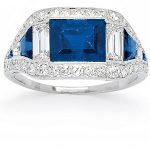
Art Deco Sapphire, Diamond and Platinum Ring, Tiffany & Co., circa 1925, sold for $12,000 at Fall 2017 Important Jewels auction.
As Holly Golightly will tell you, “Nothing very bad could happen to you there.”
She’s referring of course to Tiffany & Co.’s flagship jewellery shop on Fifth Avenue in New York City.
From their legendary heart tag bracelets to their iconic Tiffany Blue Box, Tiffany & Co. is arguably one the world’s most recognizable, popular and timeless jewellery brands.
From Art Deco era masterpieces to the modern Tiffany T collection – the debut for the brand’s first female Design Director, Francesca Amfitheatrof – Tiffany & Co. has endured in popularity for decades. Their jewels are a staple on the red carpet and their signature designs coveted by women everywhere.
Interestingly, the jewellery house didn’t start out selling jewellery, at least nothing more than costume pieces. The brand began as Tiffany & Young in 1837, purveyors of stationary and fine giftware.
It wasn’t long before Tiffany’s began offering European-imported jewellery, eventually acquiring their own stock of diamonds and gemstones. By the turn of the century, Tiffany’s had begun to solidify their reputation as an innovative and trendsetting jewellery house.

A Pink Tourmaline, Diamond and Gold Bracelet, by Tiffany & Co., sold for $46,000 at Dupuis June 2017 Important Jewels auction.
The start of signature designs
In the 1950s, Tiffany & Co. began featuring individual designers, starting with Jean Schlumberger, the creator of Tiffany’s classic “X” bangles, as well as brightly coloured, enameled animal motifs. He was the first designer the brand allowed to sign his work. His extensive Sixteen Stone and Ropetwist collections are considered new classics.
Only a handful of other designers for Tiffany’s have this honour: Paloma Picasso, Elsa Peretti and Frank Gehry.

A Diamond, Platinum and Gold ‘Lynn’ Bracelet, Schlumberger, Tiffany & Co., sold for $6,500 at Fall 2018 Important Jewels auction.
In the 70s, Peretti’s simple and elegant designs transformed the way we wear diamonds, making them suitable for every day, in addition to upgrading sterling silver. Picasso joined Tiffany’s in 1980, bringing flair and sophistication with her bold designs.
Cherished symbols of style
Not the work of a famed designer, but certainly a signature motif, is the Return to Tiffany ® collection. Perhaps the most famous of all their designs, the heart tag bracelet is at the forefront of this contemporary collection that also features pendants, bangles, cuffs and earrings, all emblazoned with the well-known phrase.

Gold ‘Atlas’ Bangle Bracelet, Tiffany & Co., coming up for sale at June 2020 Important Jewels auction.
The story behind the iconic expression goes back to 1969, with the introduction of the Return to Tiffany ® key ring inscribed with “Please Return to Tiffany & Co. New York,” and each one assigned a unique number. The idea was that if anyone were to lose their keys, they would be able to retrieve them from the famed Fifth Avenue shop.
The phrase has now simply become an invitation to visit the ultimate style and luxury locale, in the heart of NYC.
Also easily recognizable, the iconic Atlas collection featuring Roman numerals, is reminiscent of the storied clock that decorates the exterior of the flagship building. A mundane everyday object like a household key, becomes in the hands of an inspired designer, a popular selection of diamond-set pendants.
Pleasures of Keeping Current
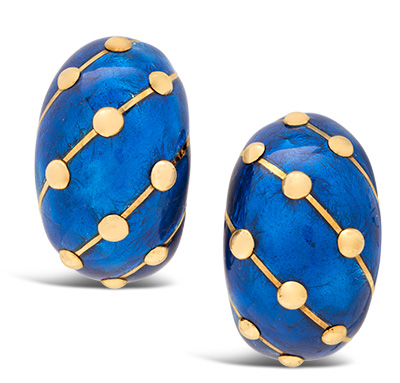
With warmer weather ahead, this usually means spring cleaning and a wardrobe overhaul. But what about your jewellery collection? Of course there are significant pieces that will always have a place in your jewellery box, but it may be time to take stock and toss certain stale accessories.
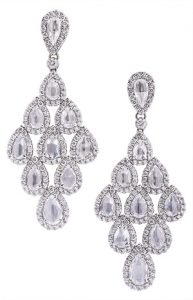
Pair of Diamond and White Gold Ear Pendants, by Myles Mindham, Spring 2020 Important Jewels Auction. Estimate: $20,000-$30,000.
How to take advantage of jewellery trends and still shop smart
The good news is that jewellery trends typically evolve at a slower rate than clothing trends, so you don’t need to strain your wallet to keep up. You can also stick to fashion jewellery for the more outrageous trends. That way you can still have some fun without overspending on something you might not get much wear out of in the long run. Save the larger investment for pieces that will remain timeless for you, regardless of what’s happening on the runway.
While taking inventory of your current jewellery collection, you can also keep an eye out for gemstones that could be rescued from a worn, dated setting and reimagined in a fresh new style. Not only is this a sustainable, economical approach to enhancing your jewels, it’s also a way to finally get some wear out of the sentimental pieces you’ve been hanging onto but would never wear in their current state. In fact, this current take on the three environmental Rs is an emerging trend in itself among jewellers, as consumers continue to care more and more about environmental impact.
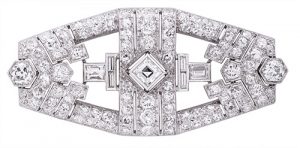
Art Deco Diamond and Platinum Brooch, Spring 2020 Important Jewels Auction. Estimate: $4,000-$6,000.
Be aware though, that very often the value is not in the intrinsic worth of any particular gem. For instance, breaking up a classic Art Deco piece into its constituent bits is a major no-no. In such a case, it’s preferable to find a different good home for it, keeping the integrity of the design; choose to sell at auction, for example, and use the proceeds for something in a style that you will enjoy wearing.
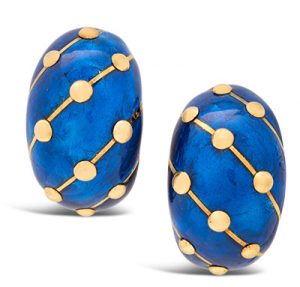
Pair of Enamel and Gold Ear Clips, Schlumberger, Tiffany & Co., Spring 2020 Important Jewels Auction. Estimate: $5,500-$7,500.
Spring jewellery trends for 2020
Let’s take a look at what Spring fashion forecasters are calling for this season – and what these new pieces could replace:
In: Supersized earrings
Hoop earrings never seem to go out of style, but this year it’s all about the power hoops: big, shiny, colourful, bold.
If you really want to make a statement, you could always opt for the single earring, a look that dominated several runways this Spring. Just make sure the earring is substantial enough to make an impact on its own.
Out: Ear crawlers & huggie earrings
Spring jewellery trends this season are spotlight stealers, not wallflowers. It’s time to trade in those easy-to-wear, but often overlooked tiny earrings and huggie hoops for something more stylish.
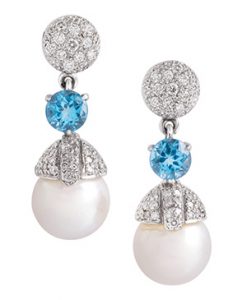
Pair of South Sea Cultured Pearl, Blue Topaz, Diamond and White Gold Ear Pendants, Spring 2020 Important Jewels Auction. Estimate: $1,000-$1,400.
In: Pearls
A feminine classic that will remain a jewellery staple, pearls are getting a lot of wear this season, and not just as a simple strand around the neck: designers are using pearls in fresh new ways, from single earrings to headpieces and even sculptured shapes.
Out: Bohemian chokers
It’s time to set aside those Coachella-esque fabric chokers. This season is inspired by more masculine styles, such as signets and medallions.
In: Colour
Designers are getting playful this spring, especially with the use of bright hues, vibrant floral motifs, candy-coloured beads, and rainbows of baguette gems. This trend is all about having fun, creating unique looks with a mishmash of stones and metals.
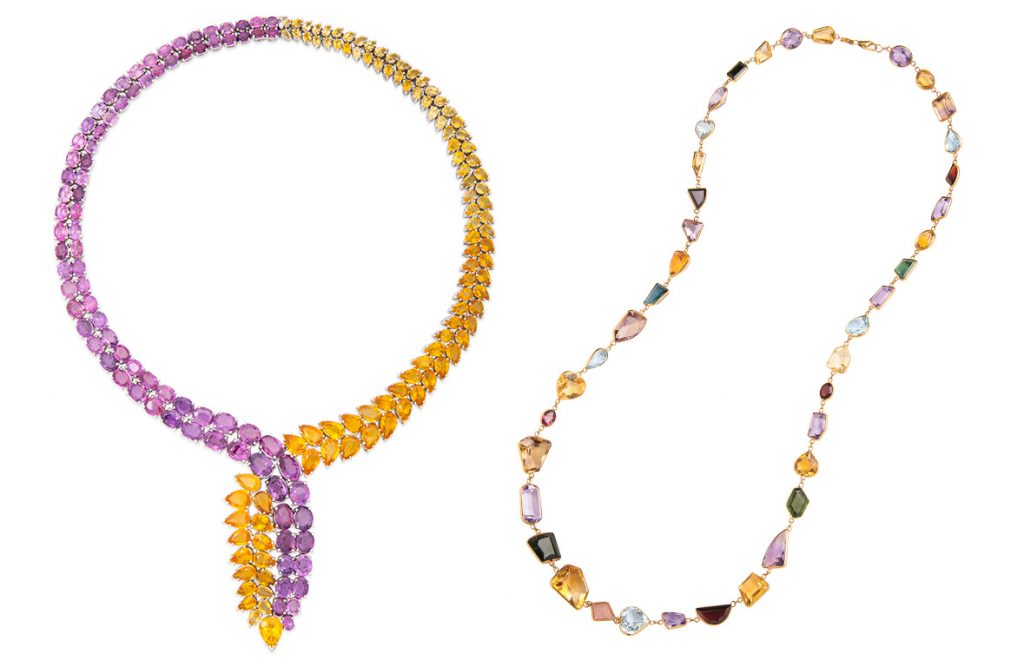
Multi-Coloured Sapphire and White Gold Necklace, Spring 2020 Important Jewels Auction. Estimate: $15,000-$20,000. (left) Multi-Gem and Gold Necklace, Spring 2020 Important Jewels Auction. Estimate: $2,000-$3,000. (right)
Out: Blackened metals
Spring brings the welcome return of sunny days and vivid colours, which leaves little room for dull or dreary metals.
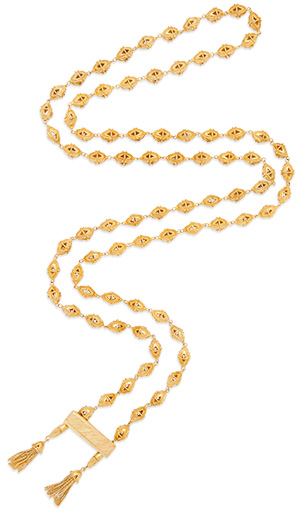
Long Gold Necklace, Spring 2020 Important Jewels Auction. Estimate: $7,000-$8,000.
In: Chains & charms
Oversized chains were huge (literally and figuratively) on the runways this Spring, from sparkling to enamel, layered to textured. Chunky links reign supreme for necklaces this Spring.
Charms and long, layered lariats are a lighter, yet just as fashionable option, worn draped around the neck like a scarf.
Out: Bib necklaces
This Spring, it’s either chunky choker or long chain – no in-between. That means bye-bye to bib necklaces.
Perhaps the biggest takeaway for what’s trending in Spring 2020 jewellery design is freedom and personalization. Customized elements, specialty-cut stones, and fearless mixing and matching will have your jewellery collection on point this season. Overly simplistic or delicate pieces are on the way out as more jewellery lovers gravitate toward bold, standout pieces that reflect their own unique personal style. But remember, if simple and delicate is your default comfort zone, experimenting can be fun. And rules are meant to be broken.
Coiling up with snake jewellery: the enduring style of the serpent motif
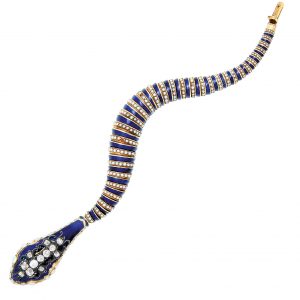

Antique Gold Caduceus Hair Ornament, by Castellani
The image of the serpent is arguably one of the most recognizable mythological symbols, steeped in history and meaning that dates back to biblical times. While snakes typically incite fear and most people would prefer to keep their distance from the creatures, when it comes to jewellery design there are few themes that draw the same iconic appeal as the snake motif.
From mythology to the runway – the history of snake symbolism
The duality of snake symbolism is most intriguing, as serpents are often seen as evil or poisonous; yet, snakes also represent transformation, fertility and healing. The ouroboros, the ancient depiction of a snake eating its own tail, symbolizes eternity and rebirth.
Ancient Mayans and Aztecs worshipped serpent gods, and the Greeks also regarded snakes as sacred. In Greek mythology, the god of medicine, Asclepius, carried a serpent-entwined staff – a symbol that is still commonly associated with the medical profession today. Ancient Egyptians viewed snakes as supernatural and regal beings, and Cleopatra herself is perhaps the first (certainly the most notable) historical figure to wear snake jewellery.
However, it wasn’t until the 1800s when the snake motif solidified itself as a renowned jewellery staple, thanks to Queen Victoria’s trendsetting engagement ring. In an era where elements of nature were often incorporated into jewellery, the snake became the perfect symbol for eternal love and commitment.
The evolution of serpent-inspired jewels
Queen Victoria’s influence and popularity catapulted the snake motif trend across England, and soon snake brooches, coiled bangles and flexible necklaces began appearing all throughout Europe.
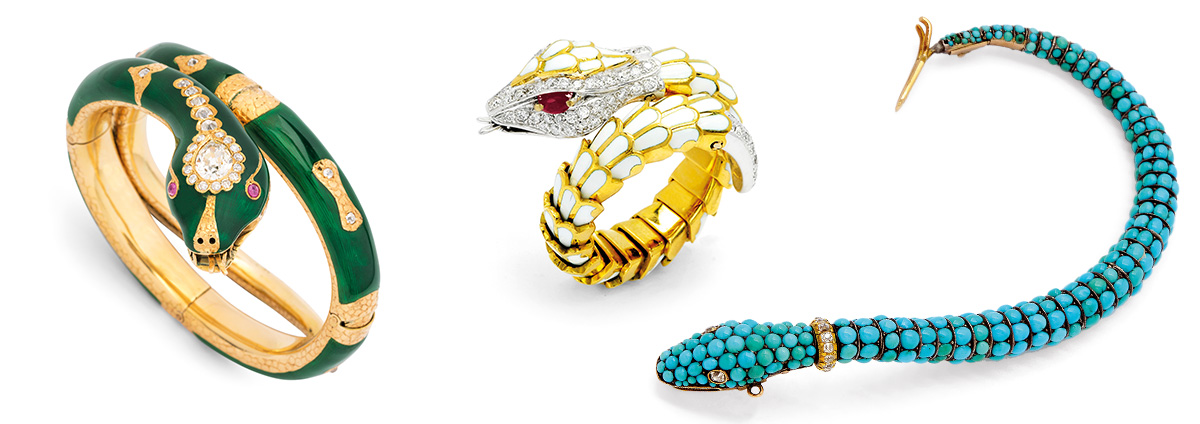
Snake motif jewels previously offered at Dupuis
This trend continued during the Art Nouveau period, with the image of the snake inspiring pieces that tied in nicely with the prominent animal motifs of the time. Through the 20th century, fine jewellery houses offered their own interpretations of the reptile:
Cartier
In the 1960s, Mexican actress Maria Félix commissioned Cartier to design a life-sized snake necklace. Taking two years to complete, the 22-inch platinum and gold serpent was fully flexible and reversible, covered in 2,473 baguette-cut diamonds, with the underside enamelled in red, green and black.
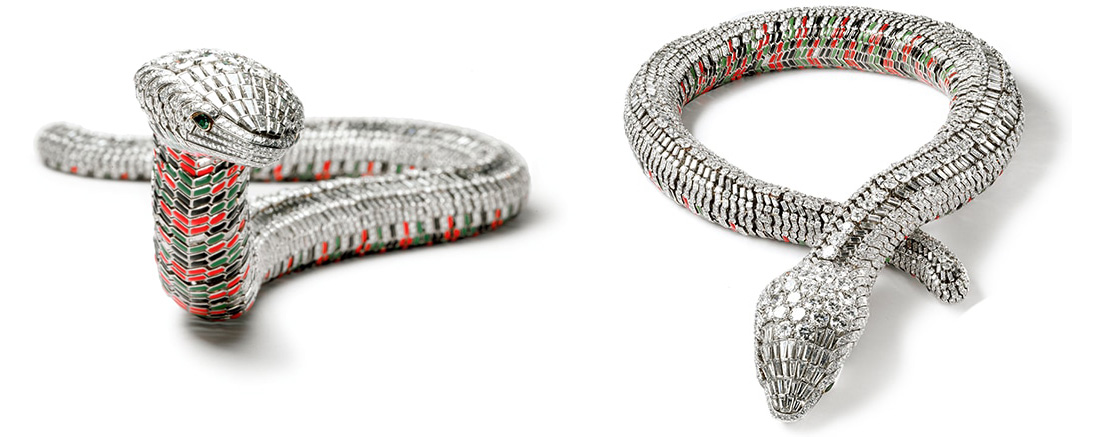
Snake Necklace by Cartier
Photo credit: Cartier.com, Cartier’s L’Odyssée de Cartier Film
Bulgari
One of the most timeless and intricate snake-themed collections is Bulgari’s Serpenti collection. Inspired by an ancient Roman practice, designers employed the Tubogas technique to create flexible, rounded bands that were comfortable and easy to wear while remaining firmly coiled – perfect to create the look of a snake wrapped around one’s wrist.
In addition to heavily featuring the unmistakable snake silhouette, the collection also showcases the head of the snake through the use of vibrantly hued gemstones. In the 1950s and 60s, Bulgari crafted several custom snake-themed pieces for fashion icons such as Elizabeth Taylor and Vogue editor Diana Vreeland.
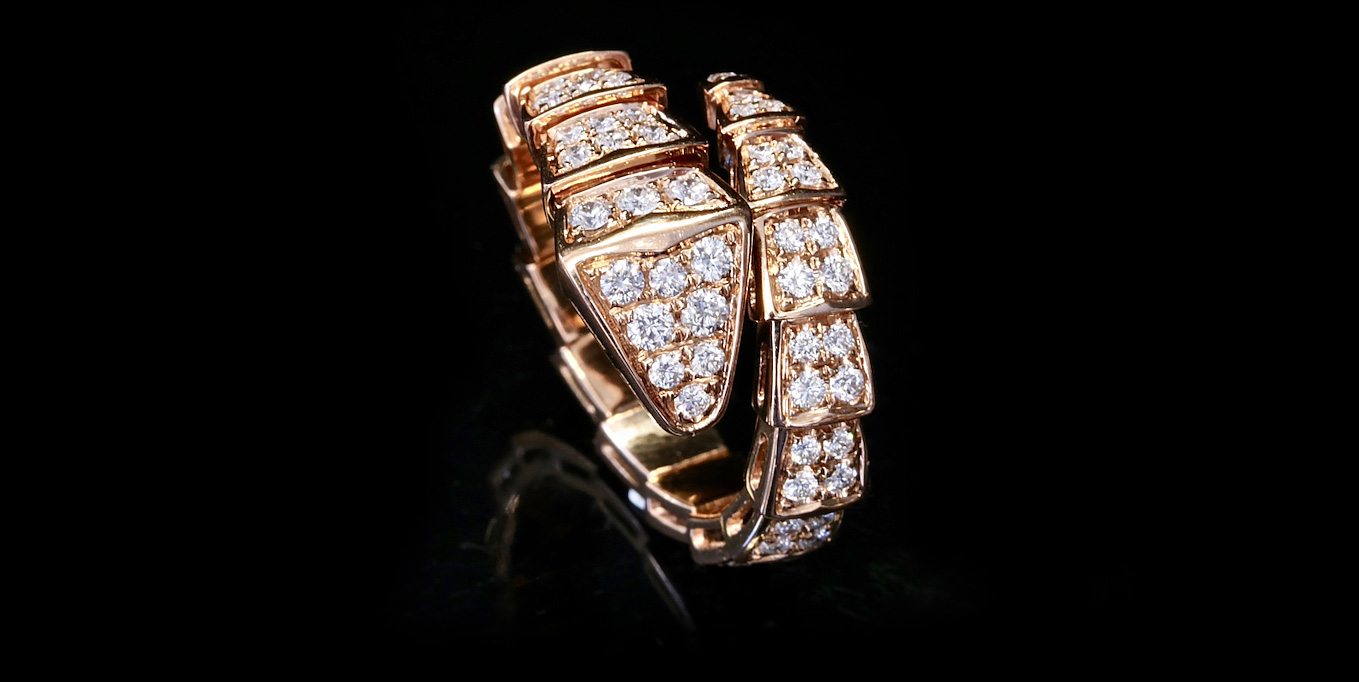
Diamond and Pink Gold ‘Serpenti’ Ring, by Bulgari
Boucheron
Boucheron has two collections dedicated to the snake motif: Serpent Bohéme and Adam. The former a more subtle nod to serpents, with engraved scales and teardrop-shaped gems that appear to be a less literal take on a snake’s head. The latter featuring more realistic renditions of the snake’s shape.

Diamond and gold ‘Adam’ bracelets, by Boucheron
Photo credit: Boucheron.com
There are countless jewellery houses across the globe that channel the exotic and mysterious allure of the serpent figure. Whether muted and delicate or bold and dramatic, the snake motif will forever be entwined in contemporary jewellery design.
Adored amethyst February’s traditional birthstone
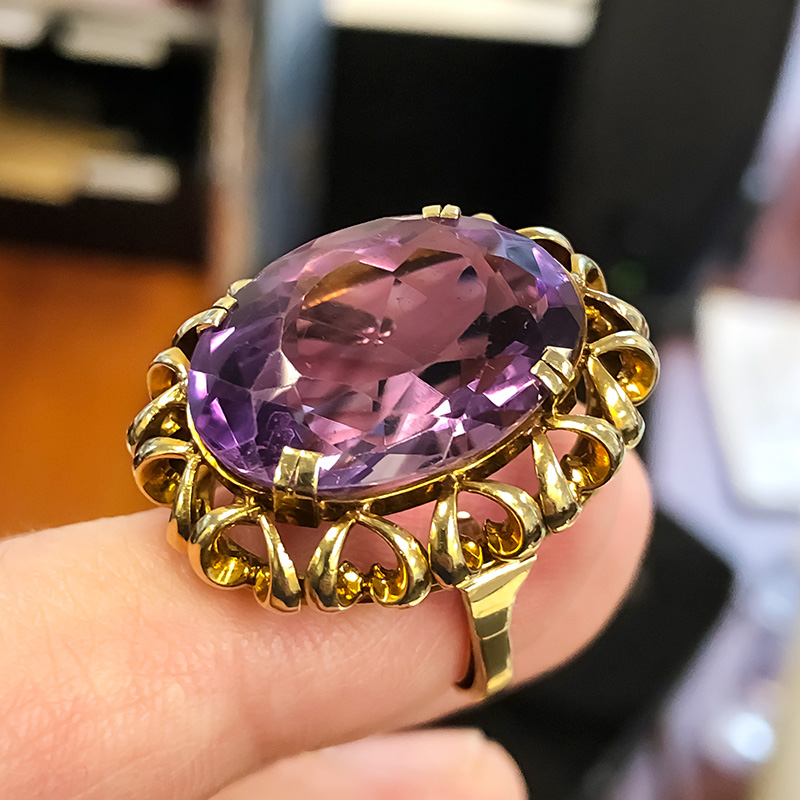
There are few gems as versatile as the amethyst: regal enough to adorn crown jewels, yet also accessible enough to enhance fashion jewellery.
Shopping for a Valentine’s Day gift or a February birthday gift? Amethyst is a stunning choice for a fine jewellery gift. Aside from its beauty, amethyst is also a stone steeped in symbolism.
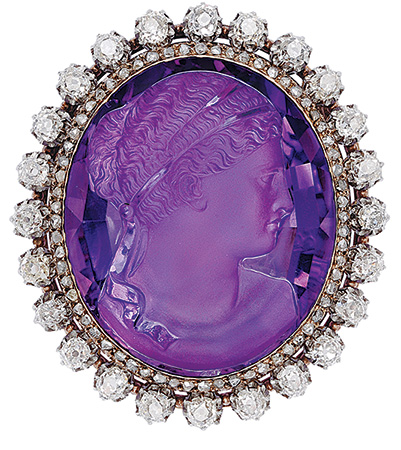
Antique Amethyst Cameo and Diamond Brooch, sold for $10,000 at Dupuis.
Amethyst birthstone history and meaning
Amethyst owes its name to its deep purple hue. Being the colour of grapes, ancient Greeks associated the gem with Bacchus, the god of wine. The belief was that wearing the stone would protect one from drunkenness. Their word for this remedy was amethystos. Still today it is often worn as a symbol of sobriety and thought useful in overcoming addiction or overindulgence of any kind.
Amethyst is considered to be a highly spiritual stone, a staple in meditation and often used in malas and Tibetan prayer beads. It is thought to enhance intuition, relieve stress, and promote balance, either stimulating or calming the mind, as appropriate.
The traditional February birthstone also has ties to royalty, thanks to its coveted colour, purple being considered a distinctly regal colour. The Russian Empress, Catherine the Great, was fond of the gem and it appeared frequently in her jewellery collection. This was during a time when amethyst was still rare and expensive, with Russia being the main source of the stone. An amethyst suite believed owned by the Empress Josephine was redesigned to include a tiara and is now part of the Swedish monarchy’s crown jewels. During the Victorian era, the stone took on a somewhat sombre use to appropriately signify a period of mourning.
In the 19th century a large amethyst deposit was discovered in Brazil, with other sources found in Africa, Bolivia, Canada and the US.
Although amethyst became less costly as it became more common, it was also given more occasion to shine, and began to appear frequently in jewellery design, especially during the Edwardian era in graceful lavalier necklaces with multiple garland festoons.
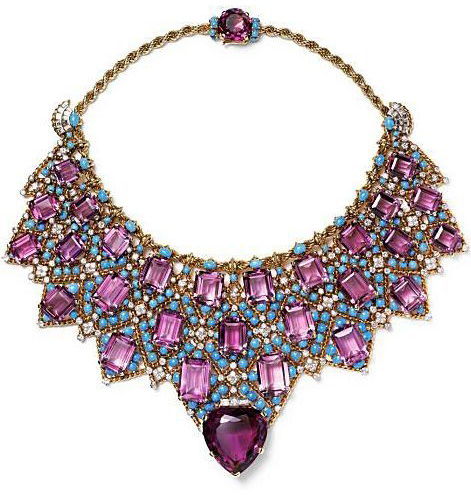
Wallis Simpson, the American socialite turned Duchess of Windsor, famously wore a Cartier amethyst and turquoise bib as part of her exquisite and memorable collection. An impressive history for a crystal considered to be a gem of personal empowerment.
Amethyst birthstone characteristics
Amethyst is a type of quartz, available in a variety of weights, shapes and sizes, from hollowed out geodes big enough to stand inside to multifaceted polished cuts and cabochon beads used by jewellery designers. The colour can range from deep plum to pastel lavender with zones of darker and lighter colours. The reddish purple shades are typically the most valuable, but all are beautiful.
Amethysts are known for their striking clarity with relatively few inclusions and rate a 7 on the Mohs hardness scale. This means amethyst is strong enough to wear daily. Still, amethyst should be stored with care to protect against scratching (from rubbing against harder gemstones or abrasive cleaners, for example). Amethyst jewellery can be cleaned with mild soap and warm water and is generally safe in an ultrasonic machine.
How to wear amethyst birthstone jewellery
If you’re drawn to bold jewellery, amethysts can often be found as a prominent feature in very large cocktail rings. Even today, it’s not uncommon to see stunning gems weighing more than 30 or 50 carats and larger set in rings or pendants.
Gems in high jewellery: reimagining “semi-precious” stones
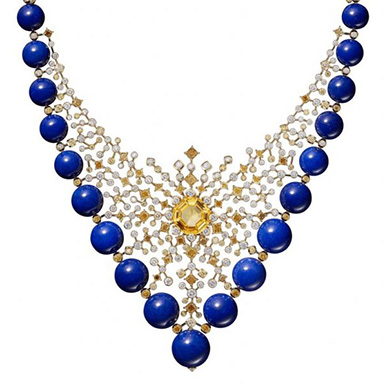
When you think of high jewellery, visions of diamonds and sapphires typically appear, along with rubies and emeralds. These “Fab Four” precious gemstones have been the cornerstones of leading jewellery houses for well over a hundred years, and will certainly continue to take centre stage.
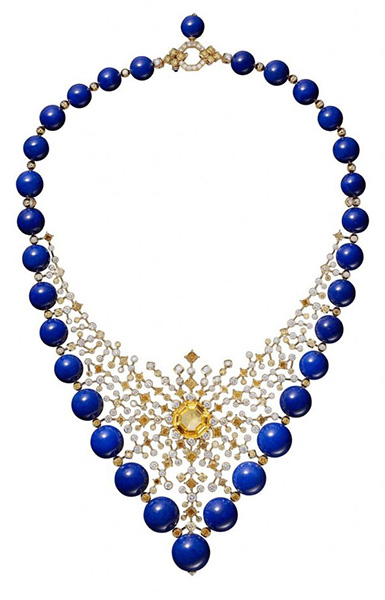
Cartier has created “a dialog between stones” with their Magnitude collection. This Equinoxe necklace features spheres of lapis lazuli surrounding lacework diamonds and yellow sapphires in yellow gold
However, as seen in several haute couture collections that debuted earlier in 2019, there is room in high jewellery for so called “semi-precious” gems in addition to our usual shiny suspects. Some in the jewellery industry find the term itself somewhat outmoded but still useful in differentiating it from the Fab Four group. Designers have no qualms about creatively using such semi-precious stones – they were front and centre in several pieces crafted by jewellery’s biggest players, proving these stones are far from inferior when it comes to fashion.
Uplevelling ornamental stones
Semi-precious gems are often reserved for fashion jewellery and generally available at a much lower price point than high jewellery. There have been notable exceptions of course, namely during the Art Deco era, known for the dramatic use of contrasting diamonds with the bold colours of black onyx, red coral and green jade in various geometric patterns. These accents were cut as cabochons, panels and plaques, again contributing to the striking juxtaposition of materials.
For many top design houses, the exotic earthiness of these shaped stones draws on a slightly different appeal than the usual spectacle of a facetted gem: in this case, gems are embraced for their typical inclusions, unique textures and saturated hues.
Semi-precious stones working in harmony with precious gems
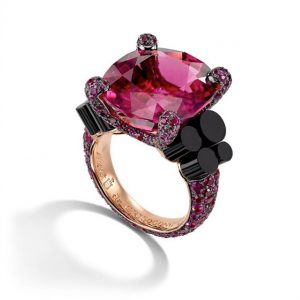
Tourmaline ring by GRISOGONO.
High jewellery’s leading designers have managed to elevate these minerals to a higher degree of status through the same level of workmanship and attention to detail you would expect from the world’s most prestigious brands, setting them in a way that brings out their natural beauty.
Combined with their more precious counterparts, an appealing aesthetic is the desired effect; for example, pairing any matte bead, such as lapis lazuli, with sparkling stones will create a distinct contrast in both colour and texture.
The union of precious and semi-precious gems can be seen in several elite collections, solidifying the acceptance of these types of stones in high fashion.
During the 72nd Cannes Film Festival in May of 2019, Swiss jeweller de GRISOGONO, showcased an haute joaillerie collection, the Art of Technicolour, a tribute to cinema featuring vivid shades and unique cuts. This pink gold ring is set with an oval-cut rubellite, flanked by smooth cylindrical-cut onyx and adorned with rubies.
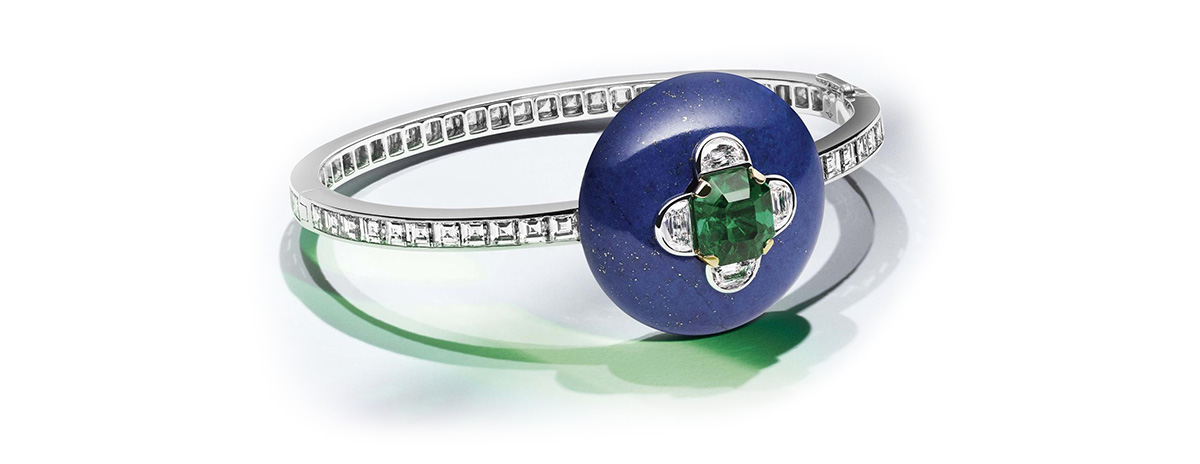
Louis Vuitton ‘Riders of the knights’ lapis, diamond and emerald bracelet.
Paying homage to Medieval heroines and heroes, Louis Vuitton’s Riders of the Knight collection launched in Paris during Couture Week. This bangle bracelet highlights gold-flecked lapis lazuli with emeralds and diamonds in white gold.
There will always be a place for precious gems; this expression of creativity and disruption of haute joaillerie traditions is making way for new innovations – a sure sign of the times and a new take on style.
Buying time: past, present and future

A luxury timepiece is a functional work of art, an accessory that makes a statement and combines practicality with individual style. If your watch of choice is a Rolex, you are entering an extensive circle of like-minded watch aficionados.
There are a few points to keep in mind before purchasing a luxury watch. Consider your purpose – is it for everyday wear or special occasions only? Rolex watches are available in a vast array of styles with a variety of features. Discerning which functions suit your lifestyle best will help you to narrow down or extend your selection.

Lady’s Diamond and Emerald ‘Oyster Perpetual DateJust’ Wristwatch, Rolex, Spring 2012 Auction.
These high-end watches are crafted from a wide variety of materials, including “Oystersteel”, Rolex’s proprietary stainless steel fabrication. Combine the brand name Rolex, plus the letter S for steel and add OR, the French word for gold and you get the popular two-tone “Rolesor” bracelet, juxtaposing stainless steel with yellow gold details; for a pinkish tinge, there’s Everose Gold; and there’s a black rubberized version, nothing basic about it; platinum and titanium, too. Light coloured dial or dark, raised signature texture, smooth or diamond encrusted, a Rolex can satisfy any design preferences.
Recognition Factor
Rolex is inarguably the most easily recognized luxury watch brand in the world. From Elvis to James Bond to Jay-Z to President Kennedy, Rolex has seen its share of legendary wearers. President Obama has been spotted wearing a slim-line Cellini on an elegant leather strap.
The dominant Jubilee and Oyster bracelets easily catch the eye, and befitting the status of a president or CEO, the President style of bracelet is manufactured only in precious metal.
Don’t discount the value of vintage
Although the latest Rolex models possess the most modern technological innovations, collectors also prize the unusual, the rarely seen, the limited series. The charm and character of a vintage piece can never be recreated – in fact, quite literally. Eaton’s quarter century models from the early 1930s have an avid following; uncommonly for Rolex, and limited to the 1970s and 80s, a battery-operated edition called the Oysterquartz was in production.
“Complicated” choices
The Submariner
The quintessential divers’ watch, the Submariner combines superlative waterproof features with sleek design and the smoothly rotating bezel promotes safety in the depths under water. It’s been perpetually popular since its introduction in 1953, supremely versatile and as attractive on land as it is useful in the sea. Famous owner: screen star Steve McQueen
 The Datejust and Day-Date
The Datejust and Day-Date
Sporting some very useful quotidian “complications”, these ever-popular models boast an enduring everyday appeal, yet comfortably straddle a larger all-purpose quality that extends from dressy, to office, to casual. Famous owner: Dr. Martin Luther King
The Daytona
The epitome of performance, with a trio of eye-catching sub-dials, the Daytona chronograph was designed with a useful stopwatch function for the professional high speed race car driver; named after the exciting Florida speedway, it’s an extremely desirable choice amongst collectors. Paul Newman, venerable actor and notable amateur motorsport enthusiast, famously wore a late 1960s Rolex Cosmograph Daytona.
There are countless options to configure your choice for the perfect luxury watch, coveted for its prestige. Considering their reputation for durability, precision time keeping and iconic good looks, there’s a suitable Rolex for every occasion; while you’re rotating through your collection, you’re on the way to enjoying a time-honoured heirloom.
Right-hand rings and what they can mean
Gone are the days when women wait for somebody else to “put a ring on it.” Ladies, single or not, are splurging on themselves and buying all types of gems, including diamonds – to wear on their right hand.

Lot 199: Diamond and White Gold Ring, Fall 2019.
As more and more women spend their own money on luxuries like jewellery, the newest version of right-hand rings is an important jewellery trend. Certainly, wearing a bright, dramatic cocktail or dinner ring has always been a way to express individual style and make a major fashion statement. The contemporary notion of a right-hand ring is a continuation of the idea of embracing one’s independence, celebrating major life moments and maybe even challenging societal norms.
What about the left hand
In the West, the left hand has traditionally been reserved for the wearing of rings that celebrate and indicate official commemorative events like an engagement, a wedding or an anniversary. We can give credit to the ancient Romans who believed that a vein of love directly connected the heart to the third finger on the left hand. A right hand jewel can be less fraught with any intentional meaning – they don’t necessarily always have to carry their own significance but can be customized to suit every individual and situation.

Diamond and Platinum Eternity Ring, by Graff. Sold for $18,000, Fall 2017.
Roots of the contemporary right-hand ring
An extremely successful DeBeers advertising campaign in the early 2000s was aimed at encouraging any woman, no matter her matrimonial status, to invest in diamond jewellery, on her own terms and at her own discretion. The ad promoted non-engagement, non-solitaire style designs, set with a multitude of small and tiny diamonds, and was summed up with this tagline: “Your left hand rocks the cradle. Your right hand rules the world.” Whether as a personal purchase or received as a gift, this inspired concept shows no signs of abating.
A right-hand ring can celebrate the birth of a child, the gem laden gift known as a “baby bauble”; an eternity band can denote a special anniversary or graduation. They can also be heirlooms, with no romantic connotation. passed down through generations. However, more commonly, they are rings that women have gifted to themselves: to mark a promotion, a milestone birthday, or even a change in matrimonial status such as a divorce. Stacked bands are a very popular look, set with either contrasting gems in white, yellow and pink gold or an allover monotone aesthetic in platinum.
Right hand jewels can still mean wedding bells
The right-hand ring is a way for women to truly express themselves, not simply advertise their marital status, however, this practice can change depending on where you are in the world.

Diamond Solitaire and White Gold Ring, Fall 2019
In Canada and the United States, engagement and wedding rings are traditionally worn on the left hand. Yet, it’s actually has been customary to wear those tokens of love on the right hand in many European countries, including Greece, Germany, Spain and Poland. German tradition has the engagement ring move from the left hand to the right after the wedding, while in Brazil and Turkey, the opposite is true. In some regions in China, woman wear their wedding band on the right hand. In the past, in a different attitudinal climate, some in the LGBTQ community, opted to wear wedding bands on the right hand to indicate a relationship.
Perhaps the best part about a right-hand ring is that there are no hard and fast rules about why or when to wear one: celebrate love for a partner (or yourself), honour an occasion, start a conversation with a statement piece. In fact, you don’t even need a reason to rock a right-hand ring, but there are certainly many great ones.
Selection of rings from upcoming auction.
Coloured gemstones or diamonds: choosing the stone that’s right for you
Diamonds may be a girl’s best friend, but what about rubies and sapphires? Coloured gemstones have long been favoured by royals and celebrities and only continue to increase in popularity. They can often be more affordable and a conversation-worthy alternative to diamond engagement rings.

How the demand for diamonds began
We know “diamonds are forever”, essentially unmatched when it comes to day-to-day durability, which is one reason why they are typically the stone of choice for engagement rings. The other reason we use diamonds to say “I do”? Clever marketing.
The historic players supplying the Western diamond market: India from the 1400s, during the 1700s major sources were found in Brazil and then huge deposits were found in 1800s South Africa. Due to their relative rarity and therefore extremely high cost, diamonds were initially only worn, in any form, by Royalty and the wealthiest of the wealthy. It wasn’t until the early 1950s when they solidified their spot at the top of the gemstone chain:De Beers Consolidated Mines, Ltd. began positioning diamond engagement rings as a symbol of love and commitment – rather than just a symbol of wealth and luxury – in a brilliant ad campaign begun in 1947 that evolved from a reaction to the extreme slump in sales after the Great Depression and post-war malaise.

Canadian Diamond Line Bracelet
Suddenly diamonds became coveted for the emotional connection they evoked, and this resulted in creating a demand unaffected by status or the economy that has held strong for decades.
The charm of coloured gems

Ruby and Diamond Ring by Van Cleef & Arpels.
There is an ever-growing interest in alternative gems. Some buyers are simply enticed by the bold statement-making appeal of a colourful gem or are perhaps drawn to the traditional meaning behind a particular stone. Certain coloured gemstones can even be more valuable and rarer than diamonds.
The big three that often come to mind when we think of precious coloured gemstones are rubies, sapphires and emeralds.
Ruby
One of the most valuable and popular gemstones, the ruby is considered the “King of Gems” and its beauty was touted in both the Bible and ancient Sanskrit texts. With its intense red hue (caused by the trace element chromium) the ruby is associated with passion, desire, power and nobility. Composed of the mineral corundum, it also has one of the highest ranking scores on the Mohs scale measuring hardness, toughness and stability, making it nearly as durable as a diamond. As practical as it is precious!

Important Sapphire and Diamond Ring, by Carvin French
Sapphire
Also composed of corundum, sapphires are suitable for everyday wear and come in virtually every colour of the rainbow, except red, when the term ruby comes into play. They are, however, commonly best known for their striking vivid blues. Steeped in fables and lore, the sapphire was a holy stone to the ancient Persians who believed the earth rested atop a sapphire formed by the heavens. The stone stands for virtue, loyalty and wisdom – ideal traits for an engagement ring!
Emerald
Dating back to the days of Cleopatra, emeralds were thought to bring good fortune and youthfulness to the wearer, a symbol of rebirth with their vibrant green hue. The emerald is the most famous member of the beryl family, and although it’s considered generally not recommended for everyday wear due to the fact that it’s not as hard as many other gems, it’s certainly a very special choice for special occasions.

Emerald and Diamond Bracelet
Don’t forget about fancy colour diamonds
Diamonds are graded on the internationally respected GIA’s scale from D to Z, from colourless to a subtle, but still noticeable, very, very pale yellow. Separate from that scale, diamonds of colour are considered “fancy” and comprise naturally occurring shades of blue, red, yellow, green, orangey, pink, brown, champagne, etc.
Unlike diamonds falling on the D-to-Z chart that become less valuable the more apparent their colour, fancy coloured diamonds actually increase in value based on the depth of hue. Colour saturation is described within a range from faint to light, to intense, to deep and ultimately, to the highly desirable, vivid.

Pair of Important Coloured Diamond Rings
Your choice, your desire
Whether you choose to opt for a more daring coloured gemstone for your engagement ring, or stick with a classic and traditional diamond, there are plenty of options to suit your budget, taste and style – the colourful or subtle choices that will flatter you are absolutely endless!
The lasting appeal of transformable jewellery
For many wearers, fine jewellery is intensely personal, a form of self-expression and individual style. Convertible jewellery pieces are a clever way to maximize this element and truly customize your collection.
Whether reconfiguring a piece completely, such as turning a tiara into a necklace, or simply connecting a pair of bracelets end-to-end, transformable jewellery allows you to create a number of different styles: take your look from day to night, from office to out on the town, from chic to glam.

An Art Deco Diamond and Platinum Necklace, circa 1930
Perhaps the most appealing part of convertible jewellery is the practical aspect. Not only do you get to enjoy wearing the same piece multiple ways, this idea speaks to the minimalism trend – Marie Kondo would have to agree a beautiful piece of fine jewellery that eliminates the need for several other pieces would definitely spark joy. Transformable pieces are also ideal for travelling, since you will only need to pack one or two pieces but will still able to enjoy several different looks.
You also get greater cost per wear value from your jewellery collection – without having to sacrifice and settle for lower quality. You still get fine craftsmanship without breaking the budget. The luxury version of two for the price of one!

Diamond ring with jacket of organic freeform design.
What exactly is convertible jewellery?
Convertible jewellery is essentially an item that can shape-shift via an easy and somewhat temporary modification without the need to dash over to your local jewellery professional: it’s something you can do on your own, in the privacy of your own home, no special skillset or professional tools required, thus giving the illusion there’s more than one piece in play, rather than just a single jewellery item.

A Pair of Emerald and Diamond Ear Pendants, by Buccellati.
Transformable designs can be achieved in myriad ways: attaching or removing an elaborate drop pendant from a simpler surmount creates the style known as a Day/Night earring; four matching bracelets attach to form a long necklace, and vice versa, that same long necklace divides to be worn as a shorter version with a single bracelet. One of the most common examples would be a double-clip brooch that separates into a pair of brooches. For a special event, your simple diamond solitaire ring can take centre stage amidst a removable bejewelled “jacket” that slips over the main stone. Classic diamond studs can also benefit from the same type of embellishment. The possibilities are limitless and a true testament to a designer’s skill.
From necessity to luxury
Convertible jewellery first began trending after the stock market crash in 1929 and the early years of the Great Depression. Clever and creative jewellery houses acknowledged the tough times, but also saw an opportunity that allowed them to market to women with tighter purse strings: versatile, economical and very appealing.
Something born out of practicality soon became something coveted in its own right, inspiring remarkable feats of design that have earned prominent houses a place in history with their technical intricacy. The innovations of luxury brands such as Van Cleef & Arpels, Cartier and Chaumet have made a mark that’s left a lasting impression on the world of jewellery design.
Iconic transformable jewellery
Convertible jewellery pieces are still very much haute couture, as revivals of this trend gain notice on Paris runways, with debuts from De Beers, Anna Hu and Piaget in recent years.
Then there are the absolutely iconic transformable pieces, either original to, or inspired by the Art Deco era, having earned their place in fine jewellery history.

ZIP necklace by Van Cleef & Arpels. Photo credit: Van Cleef & Arpels, vancleefarpels.com
Arguably the most notable piece of transformable jewellery is the famous Zip necklace by Van Cleef & Arpels, an idea inspired by the Duchess of Windsor in the 1930s, and the first zipper crafted from precious metal. The design can be worn as a bracelet or a necklace and took years to perfect.
Transformable jewels from the upcoming auction.
Puttin’ On the Ritz with Art Deco jewellery
If you think of the high-spirited, high society Roaring Twenties, then fun, fashion and frolic might come to mind. It was the birth of the Art Deco era with its heightened predisposition to notorious and extravagant glamour. Daring designs emerged, most especially in jeweller that continues to be popular today.
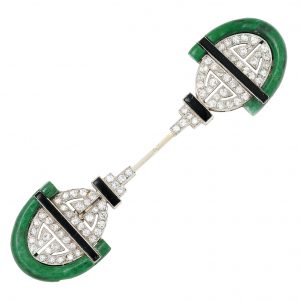
Lot 74 An Art Deco Jadeite, Onyx, Diamond and Platinum Jabot Pin, by Lacloche Frères
Defining Art Deco
The Art Deco era occurred in the midst of a prosperous Post-war economy, Thriving industries, including those dealing in precious jewellery, were actively and enthusiastically supported by the gentry. Times and morés were changing and such strictures, particularly for women, were beginning to relax, leading to a new sense of freedom and the power to express their individuality through their accessories. Those so inclined were able to lavish money, or more likely their husband’s money, on luxuries like fine jewels. Advancements in materials and methods allowed designers to take new risks in design.
The period is mainly considered to span from the 1920s to the 1930s, and was popularized at the hugely important exhibit of designers and manufacturers invited to show the world their latest and greatest innovations in Paris in 1925. The scope of the new look was vast and influenced not just jewellery but everything from fine art, to household items and architecture: picture the silhouettes of New York’s landmark Chrysler and Empire State buildings. Subsequently, the term Art Deco was coined only in the 1960s to categorize the overall style and the name is credited to Art historian Bevis Hillier who derived it from that highly significant 1925 gathering, the Exposition Internationale des Arts Decoratifs et Industriels Moderne.
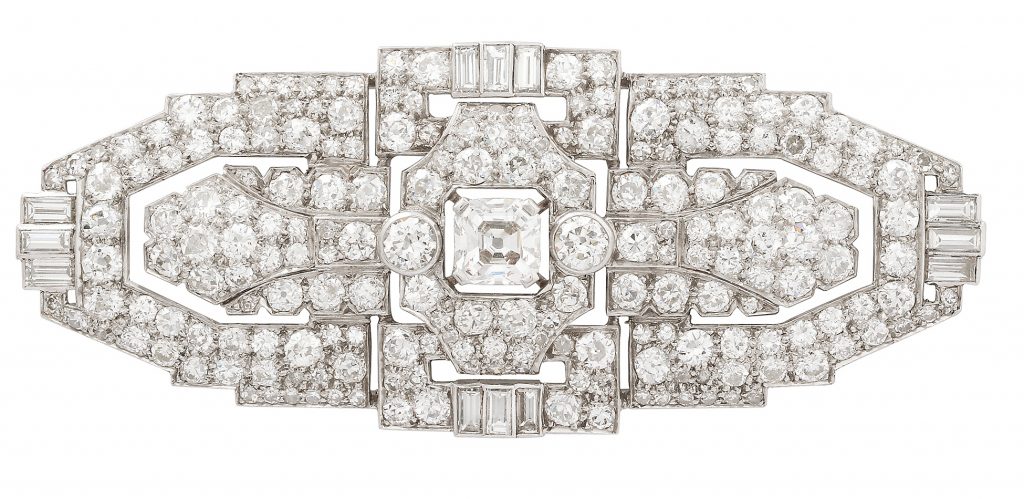
Lot 296 An Art Deco Diamond and Platinum Brooch, circa 1930.
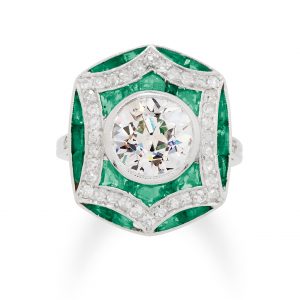
Lot 290 An Art Deco Diamond, Emerald and Platinum Ring, circa 1920
How to spot Art Deco
Geometric patterns
Signature design elements include precisely defined angles, regimented linear qualities and a more industrial feel via pleasingly repetitive and symmetrical patterns. Bold shapes and strong grid-like lines and tiered stepped edges are the calling cards of Art Deco. Look for rectangles, triangles, circles and squares. Mitre-shaped terminals are also indicative of popular motifs, whether singly or as part of convertible double-clip brooches.
Old-cut diamonds
Look for round old European-cuts which overlap in time and evolve into the scintillating transitional-cut. The elegant squared, Asscher-cuts are obviously evocative of the era and are still surprisingly modern looking. Commonly, smaller accent diamonds are baguette, bullet-cut and shield-shaped.
Platinum and white gold
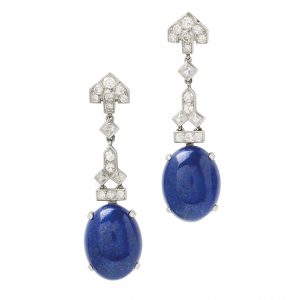
Lot 222 An Art Deco Pair of Lapis Lazuli, Diamond and Platinum Ear Pendants, by Cartier
White metals were in vogue during the Art Deco era, especially platinum, while white gold was considered a popular substitute and a more affordable alternative with a similar look.
Colour in gemstones
Art Deco pieces often get their bright colours from rubies, emeralds and sapphires, sometimes seen in Tutti-Frutti carved leaves or what’s known as calibré-cut, rows of very small multiple gems that are customized to fit narrow specialty channels and uniformly spaced tightly together rather than individually amid visible claw settings. Jade, black onyx, coral, rock crystal and lapis lazuli effectively create harmonious combinations of striking contrast when paired with diamonds.
Drawn to Art Deco?
Art Deco retains its influence with a unique ability to channel vintage elegance while still evoking a contemporary feel. This universal modern appeal widens its desirability among fashion enthusiasts. If you’re craving a genuine statement piece to reflect your personal style, consider the timeless allure of Art Deco jewellery.
Dupuis Fine Jewellery Auctioneers offers several unique and hard-to-find pieces sure to speak to your inner flapper:

